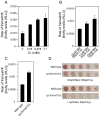Chromate-induced sulfur starvation and mRNA mistranslation in yeast are linked in a common mechanism of Cr toxicity
- PMID: 20637279
- PMCID: PMC2932861
- DOI: 10.1016/j.tiv.2010.07.006
Chromate-induced sulfur starvation and mRNA mistranslation in yeast are linked in a common mechanism of Cr toxicity
Abstract
Toxicity of the environmental carcinogen chromate is known to involve sulfur starvation and also error-prone mRNA translation. Here we reconcile those facts using the yeast model. We demonstrate that: (i) cysteine and methionine starvation mimic Cr-induced translation errors, (ii) genetic suppression of S starvation suppresses Cr-induced mistranslation, and (iii) mistranslation requires cysteine and methionine biosynthesis. Therefore, Cr-induced S starvation is the cause of mRNA mistranslation. This establishes a single, novel pathway mediating the toxicity of chromate.
Keywords: Chromate toxicity; Saccharomyces cerevisiae; Sul1; frameshift; sulfate transport.
Copyright 2010 Elsevier Ltd. All rights reserved.
Figures



Similar articles
-
Effect of cadmium on mRNA mistranslation in Saccharomyces cerevisiae.J Basic Microbiol. 2020 Apr;60(4):372-379. doi: 10.1002/jobm.201900495. Epub 2020 Jan 8. J Basic Microbiol. 2020. PMID: 31912517
-
Chromate causes sulfur starvation in yeast.Toxicol Sci. 2008 Dec;106(2):400-12. doi: 10.1093/toxsci/kfn193. Epub 2008 Sep 15. Toxicol Sci. 2008. PMID: 18794233
-
Chromate toxicity and the role of sulfur.Metallomics. 2011 Nov;3(11):1119-23. doi: 10.1039/c1mt00059d. Epub 2011 Aug 1. Metallomics. 2011. PMID: 21804974 Review.
-
Mistranslation of human phosphoglycerate kinase in yeast in the presence of paromomycin.Curr Genet. 1994 Aug;26(2):95-9. doi: 10.1007/BF00313794. Curr Genet. 1994. PMID: 8001177
-
Molecular genetics of sulfur assimilation in filamentous fungi and yeast.Annu Rev Microbiol. 1997;51:73-96. doi: 10.1146/annurev.micro.51.1.73. Annu Rev Microbiol. 1997. PMID: 9343344 Review.
Cited by
-
Novel, Synergistic Antifungal Combinations that Target Translation Fidelity.Sci Rep. 2015 Nov 17;5:16700. doi: 10.1038/srep16700. Sci Rep. 2015. PMID: 26573415 Free PMC article.
-
The Candidate Antimalarial Drug MMV665909 Causes Oxygen-Dependent mRNA Mistranslation and Synergizes with Quinoline-Derived Antimalarials.Antimicrob Agents Chemother. 2017 Aug 24;61(9):e00459-17. doi: 10.1128/AAC.00459-17. Print 2017 Sep. Antimicrob Agents Chemother. 2017. PMID: 28652237 Free PMC article.
-
Exposure to selenomethionine causes selenocysteine misincorporation and protein aggregation in Saccharomyces cerevisiae.Sci Rep. 2017 Mar 17;7:44761. doi: 10.1038/srep44761. Sci Rep. 2017. PMID: 28303947 Free PMC article.
-
Flavonoids: Potential Candidates for the Treatment of Neurodegenerative Disorders.Biomedicines. 2021 Jan 20;9(2):99. doi: 10.3390/biomedicines9020099. Biomedicines. 2021. PMID: 33498503 Free PMC article. Review.
-
Novel Combinations of Agents Targeting Translation That Synergistically Inhibit Fungal Pathogens.Front Microbiol. 2018 Oct 4;9:2355. doi: 10.3389/fmicb.2018.02355. eCollection 2018. Front Microbiol. 2018. PMID: 30349511 Free PMC article.
References
-
- Ausubel FM, Brent R, Kingston RE, Moore DD, Seidman JG, Struhl K. Current Protocols in Molecular Biology. John Wiley and Sons; New York: 2007.
-
- Avery AM, Willetts SA, Avery SV. Genetic dissection of the phospholipid hydroperoxidase activity of yeast Gpx3 reveals its functional importance. Journal of Biological Chemistry. 2004;279:46652–46658. - PubMed
-
- Alexander J, Aaseth J. Uptake of chromate in human red blood cells and isolated rat liver cells: the role of the anion carrier. Analyst. 1995;120:931–933. - PubMed
-
- Bishop AL, Rab FA, Sumner ER, Avery SV. Phenotypic heterogeneity can enhance rare-cell survival in ‘stress-sensitive’ yeast populations. Molecular Microbiology. 2007;63:507–520. - PubMed
Publication types
MeSH terms
Substances
Grants and funding
LinkOut - more resources
Full Text Sources
Molecular Biology Databases

